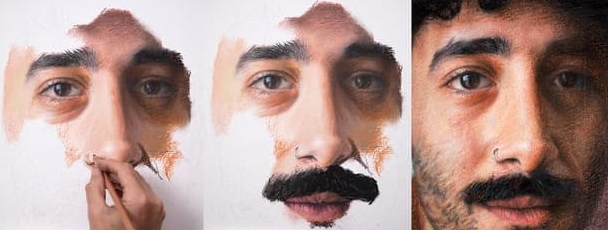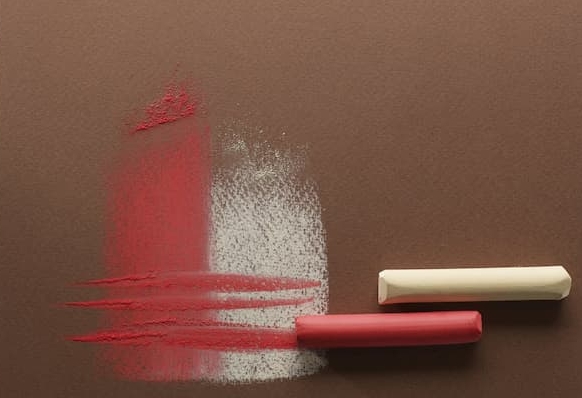
Both for its opacity and its application, pastel paint is a fascinating paint to work with. This technique is unique because it combines drawing with painting: pastel is drawn precisely the same way as the spaces are then painted… Want to know more? Don’t miss this tutorial on how to paint with pastel step by step!
How to paint with pastel
For those who don’t know it, pastel is dry paint in a format similar to chalk. There are more complex or softer pastels depending on their composition, but the design is always identical. A stick or half a post of pressed pigment:

Both for its opacity and its application, pastel paint is a fascinating paint to work with. This technique is exceptional because it combines drawing with painting: In pastel, you draw precisely the same way you paint the spaces… Want to know more? Don’t miss this tutorial on how to paint with pastel step by step!
What do I need to paint pastel?
Pastel paper
Before you start, you will need support to paint with pastel. This technique is not too demanding in this aspect, so you can use cardboard, wood, or paper. We recommend the latter, and the rougher, the better. There are many unique papers for pastel. They usually have a very rough texture to retain the pigment correctly. Among our favorites are the Canson Mi-Teintes and Mi-Teintes Touch lines.
Pastel paints
There are hundreds of brands of pastel paints. If you are starting to paint with pastels, we recommend that you start with a small case. One of the main characteristics of pastel is its blending power, so you have to try it! Among our favorite ranges are the Rembrandt dry pastels. A degree at a reasonable price, excellent quality, and with an incomparable color chart.
Fixative for pastels
Finally, it would be best if you got your hands on a pastel fixative. This technique does not dry as it does not contain any wet element in its composition. For this reason, the pastel also does not set by itself, so it is necessary to apply a fixative.
How to paint with pastels, step by step
Preparation and sketch
Before starting to paint with pastels, you must prepare the surface. To do this, prepare the paper on a table or a lectern. Put paints and a cloth nearby, so they are easy to get to. We will use this rag to wipe off excess pigment.
When you have the pastel paper ready, make a sketch of the drawing with thin strokes. Our recommendation is that you use a yellow or orange pastel to make the sketch. Although we cannot see it with the naked eye, all objects include warm orange. For this reason, this range of colors will never be too much in the final drawing.
Painting with pastels
When you have the limits and proportions represented, it is time to start painting with pastels. In this step, you should begin using colors similar to the actual colors of the object. For the first layer of pastel, we recommend using the paint horizontally and without much force. Putting too much pigment in this first layer is not recommended, as you can always add more but not remove it.

Once you have the colors represented in your work, it is time to start blurring the color. To mix the colors, you can use your fingers or the edge of your hand. You must take into account not to “rub” the drawing too much: our skin is oily, and little by little, we are transmitting it to the pastel that ends up losing its natural shine.
Something significant to keep in mind is the importance of cleaning your hands well. If you use the same finger, you will contaminate the colors and dirty the work. And we don’t have as many fingers as colors!
Finishing and fixing
Once you have finished painting in general lines comes the final touch, the moment to apply highlights and shadows. For shading, it is recommended to blend the pastel with your hand. This way, the colors will blend more naturally, like a shadow. In the case of the highlights, it is better to use thin pastel strokes and leave them untouched without altering them with the fingers.
Finally, when we think we have finished, it is necessary to fix the pastel; otherwise, the slightest rubbing could spoil the creation completely. Some people use hairspray to improve their works, it is not very advisable because it moistens the paper too much and can undulate it, better use fixatives for pastel.
A course of painting with pastel
Now that you know how to paint with pastel, we want to help you go one step further. If you would like to further learn how to make realistic portraits with pastel, this course is for you! Just released, the practical pastel portrait course has already been taken by more than 1000 students.
Thanks to its online format, you can learn to paint with pastel at your own pace from the hand of the artist Maximiliano Bagnasco. After the 17 classes taught by Maxi, you will learn how to capture the essence of a face through a photograph. Learn how to make realistic portraits with pastel and dedicate yourself to what you love.
Pastel is a relatively simple technique to handle; we can start representing still lifes or landscapes that are very grateful in this technique and increase the level to reach the height of Edgar Degas’ Dancers. Do you dare with his impressionist paintings?
Can pastels be used as paint?
Yes. Pastels can be used as paint, but they are not typically used as such.
Pastels are commonly used for drawing and sketching because of their soft, smooth texture. However, they can also be used for painting if mixed with other mediums, such as oil or acrylic paints. In fact, some artists use pastels exclusively for their paintings because of the unique textures and colors that they can create.